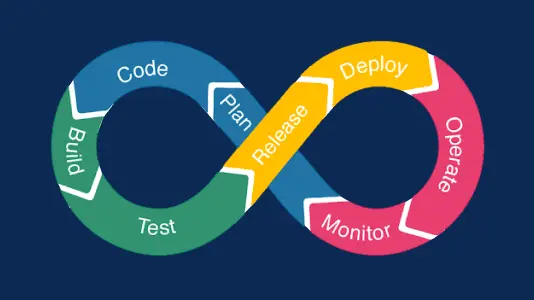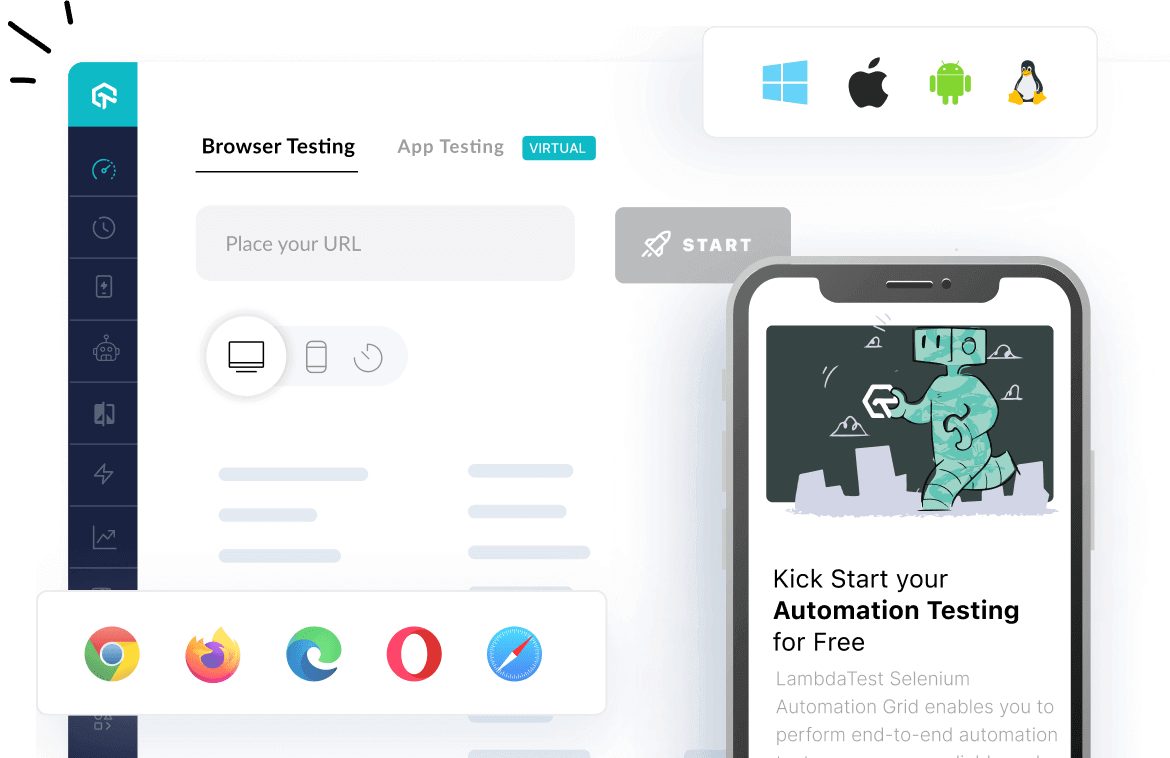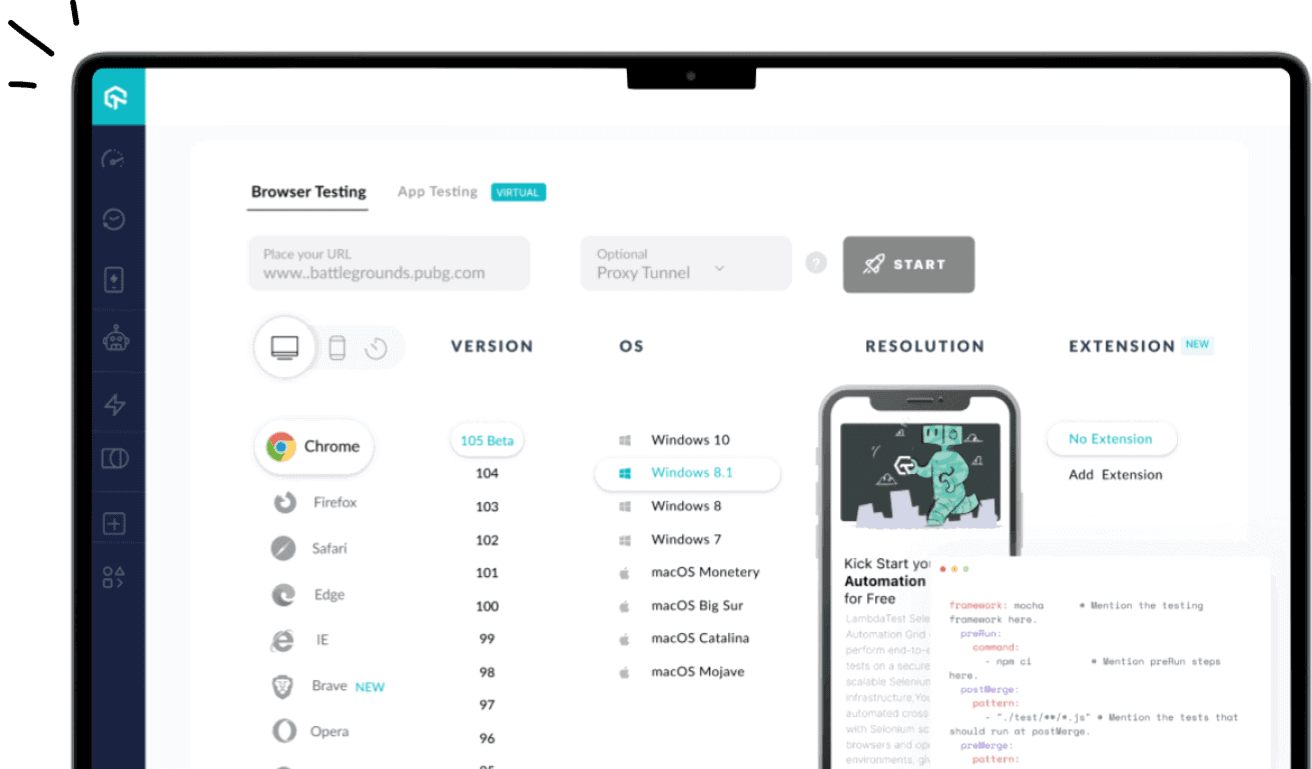- Automation
- Home
- /
- Learning Hub
- /
- DevOps Automation Tutorial
- -
- July 26 2023
What is DevOps Automation: How to Get Started
Discover the power of DevOps automation. Simplify workflows, deploy faster, and boost efficiency with this comprehensive tutorial.
OVERVIEW
DevOps automation refers to the process of automating various tasks and workflows within the DevOps (Development and Operations) environment. DevOps is a set of practices that combines software development (Dev) and IT operations (Ops) to improve collaboration and efficiency in the Software Development Life Cycle.
DevOps and automation are two essential elements that aid organizations in streamlining the development process. This causes substantial changes, such as collaboration between departments and teams should be improved, and repetitive manual work should be automated.
The SDLC becomes more effective when DevOps and automation are combined. To properly comprehend each word, let's define DevOps and automation individually.
The term DevOps refers to the combination of development and operations. It brings together the benefits of development and operations to enhance workflows. A cross-functional product team in DevOps is intended to manage features from development to production with the aid of developers and IT Ops.
In contrast, automation is applying technology to tasks requiring less human involvement. You can speed up processes, scale environments, and create continuous integration, delivery, and deployment (CI/CD) workflows with automation.
What is DevOps Automation?
DevOps automation is an approach to facilitate DevOps practices while minimizing the need for human interaction. Tools, specific practices, and processes are used in DevOps automation to automate manual and repetitive work.
With DevOps automation, you can accelerate the pace, effectiveness, and dependability of the software development process. Software engineering and information technology practices are combined in DevOps automation to enable automation and continuous delivery of software-related products.
Automation scripts can be used to automate DevOps procedures. These automation scripts guarantee quick software testing and consistent, dependable, and repeatable deployment. Organizations can decrease time to market, increase the quality of their software, and streamline other activities.
Why DevOps Automation?
The DevOps cycle should be automated to achieve the following two goals:
- Increasing cross-team cooperation
- Automate routine, laborious, error-prone, and repetitive tasks.
Automation is a guiding principle for DevOps teams that supports all other DevOps principles. By enabling team members to automate repetitive and normal chores so that they may spend more time working with each other and less time on tiresome manual work, it fosters improved collaboration and communication.

Also, DevOps teams have more time for brainstorming, writing new code, testing new code, etc., with automation. By assuring efficient and reliable procedures, it also makes observability, improvement, and shift-left practice possible. Additionally, it complements declarative configuration management.
Note : Automate your website testing across 3000+ environments. Try LambdaTest Now!
What DevOps Processes Should be Automated?
The simple answer to this question is - almost everything that can be automated. In reality, however, the automated operations depend on outside variables like:
- Organization requirements
- Technology viability.
A competent DevOps team will be able to determine which procedures in their DevOps life cycle should be automated. Here are some typical procedures that would benefit greatly from automation.
- CI/CD (Continuous Integration/Continuous Delivery).
- Builds
- Code Commits.
- The deployment of packaged applications in specific testing and production environments.
- Software testing.
- Streamlined unit tests
- UX tests
- Smell testing.
- User interaction experiments.
- Monitoring.
- Availability of infrastructure
- Concerns with performance, security, etc.
- Infrastructure management.
- Logs management.
- Provisioning.
- Deployment.
In any organization, CI/CD is the primary element that needs to be automated, according to the fundamental ideas and methods defining Agile development. All facets of this can be automated:
This is the perfect area to use automation everywhere. It is now simpler than ever to automate any type of test using test automation technologies like Selenium and Playwright. These might be:
Keeping track of components and modifications is extremely difficult due to the rapid pace of development. Automation is advantageous because it enables the DevOps team to develop automatic monitoring rules and produce alerts to monitor:
Automating the setup, configuration, and maintenance of infrastructure, such as networks and servers, can consume a substantial amount of time. However, by implementing software-defined infrastructure, we can revolutionize how we manage these systems, enabling seamless automation and minimizing the need for human intervention.
Logs are crucial for finding problems in an application. It's possible for an application to produce plenty of logs. You can quickly identify software problems using automation, log management technologies, and gathering and analyzing these data.
Automated provisioning, a key component of DevOps, allows you to provide computer resources on demand without requiring manual intervention. The organization can deliver apps more quickly than before by offering a flexible, scalable architecture that is highly scalable and has dynamic resource allocation.
The synchronization and deployment of resources across the dynamic infrastructure are made possible by deploying DevOps technologies. Deployment automation offers a robust framework that maintains synchronization of computing resources (both manually and automatically provisioned) when modifications are made.
Catch up on the latest tutorials around Selenium automation, Cypress testing, CI/CD, and more. Subscribe to the LambdaTest YouTube Channel for quick updates.
Benefits of DevOps Automation
Here are some compelling benefits of implementing automation in DevOps in your organization:
- Consistency
- Scalability
- Speed
- Flexibility
Using a robotic process automation solution throughout each stage of the DevOps cycle can help you improve the consistency of your product, app, or service. Robots are error-free unless the code is flawed.
Any highly automated process or operation has a consistent and foreseeable outcome. You've basically eliminated user errors because of the underlying static programme configuration and the absence of human interaction. Therefore, employ automated DevOps if you need to produce additional versions of software or services for diverse hardware and software platforms.
Scaling automated processes is significantly simpler than scaling manual ones. Scale automation operations by merely adding new processes to accommodate the rising demands.
The availability of team members substantially limits any scaling in a manual system. In contrast, scaling in an automated environment is only limited by the availability of the underlying software and hardware, which is not a problem in cloud-based systems as resources are scaled automatically in response to workload. Automatic Scale In/Out and Up/Down Functions is an excellent illustration of this.
The capacity to go through the life cycle stages quickly substantially impacts the project's deliverability, making it one of the most crucial aspects of DevOps.
We can complete each step without any delays because an automated process will be carried out independent of the time or availability of team members to initiate the operation manually. Additionally, using a standard template to automate a procedure is usually always faster than doing it by hand.
We can be flexible with automation regarding the process's scope and functionality.
The primary limitation on functionality and scope in an automated process is often the configuration, which can be easily adjusted to meet specific requirements. This adaptability surpasses the traditional approach of training team members to accommodate process changes. Moreover, the automated system allows for seamless updates of brand visuals across all products and services, providing added flexibility and enhanced features.
You must make quick configuration adjustments to apply across services and products in an automated DevOps approach. Consequently, you can continue to compete for changes in the market dynamics.
Keys Considerations for DevOps Automation
Prior to outlining the automation requirements and its integration into the DevOps life cycle, there are several essential considerations that need attention.
- Embrace open standards: Opt for automation services that adhere to open standards. This choice simplifies the onboarding process and minimizes the need for specialized training. Even as team members come and go, you won't find yourself constantly switching tools. This approach gains even more significance when shifting DevOps and deployment to cloud-based solutions.
- Implement dynamic variables: Prioritize the creation of reusable code to minimize rework and duplication efforts. Securely utilizing externally defined variables allows for easy automation application across different environments without modifying the core code.
- Prioritize flexibility in tools: Opt for DevOps tools that offer flexibility and adaptability to changing technologies. Using solutions with broad ecosystems empowers you to apply best practices in various scenarios. By focusing on flexible tools from the outset, you can leverage one of the critical advantages of DevOps automation.
Types of DevOps Automation
In a business, the types of DevOps automation can vary based on factors such as the industry, customer base, market size, investments, and cloud adoption. Here are some standard types of DevOps automation that you can use:
- Automated testing: This type of automation involves running tests that identify defects, errors, security vulnerabilities, and bugs early in the continuous integration and continuous delivery pipeline. By doing this, it ensures that your products, services, or apps are regularly delivered to users with high quality and security.
- Automated CI/CD: Agile DevOps teams often adopt these automated pipelines to develop high-quality and secure code. Automating CI/CD processes is essential to meet critical business needs. Additionally, you can even extend this automation to continuous deployment, where successful modifications and updates are automatically sent to the production level, as needed.
- Automatic collaboration: Setting up meetings and brainstorming sessions can be time-consuming for DevOps teams, and it's not ideal for engineers to be occupied with these tasks. But with automation in DevOps collaboration, you can use various tools like Bitbucket Server, Atlassian Confluence, Microsoft Teams, Atlassian Jira, Basecamp, etc. , to facilitate automated collaboration.
- Automated network provisioning: This type of DevOps automation ensures that developers always have access to the necessary computing resources when they need them, without having to get involved in system configuration. Tools like Kubernetes, Containers, and others can be used to provision network and computing platforms effortlessly.
- Automatic application monitoring: To keep track of your DevOps project's performance, you can set up automated app and service monitoring tools. These tools will automatically monitor for any downtimes, service issues, bugs, latencies, and more. This not only reduces the mean time to repair (MTTR) but also allows you to feed data through dynamic environment manager (DEM) tools for further optimization.
Different DevOps monitoring tools also help ensure optimal performance and delivery of your software applications.
DevOps Automation Metrics
Effective DevOps automation is crucial for organizations that want to grow and succeed, and expanding DevOps to more software applications is essential for digital transformation.
As your team embarks on its journey towards DevOps automation, it's crucial to keep track of key DevOps metrics. These metrics not only help you assess your progress but also convince reluctant stakeholders to get on board with the changes:
- Deployment frequency: This measures how often a team successfully releases updates to production. It's a great way to gauge the efficiency and speed of your DevOps process in both the short and long term.
- Deployment speed: This refers to the time it takes to roll out a CI/CD deployment into production after it gets approval.
- Change failure rate: It's the percentage of code changes in your DevOps process that lead to failures in production. Keeping this rate low is essential for maintaining a stable and reliable system.
- MTTR (Mean Time to Recovery): MTTR measures the time it takes for your organization to recover from either a partial service interruption or a total failure in production. The quicker the recovery, the better it is for your users and business.
- Defect escape rate: This metric tracks the rate of issues and bugs that escape testing and end up affecting your software application after it's in production. Minimizing this rate is vital to providing a smooth user experience.
- Application availability: This measures the time your application is available and fully functional for end-users. It's an essential aspect of monitoring your digital experience and ensuring your customers have a positive interaction with your software.
By keeping an eye on these metrics and continuously working on improving them, your team can make the most of DevOps automation and drive your organization towards success
Note : Automate tests using CI/CD tools. Try LambdaTest Now!
How to Choose a DevOps Automation Tool?
The market for DevOps solutions is oversaturated, with options ranging from Agile collaboration platforms to frameworks that enable continuous delivery, making it challenging to select the best one for your business. But you won't find any advice on how to choose one.
The truth is that only some DevOps solutions can meet the specific requirements of every organization. We'll go over the best method for choosing the appropriate tools for your business in this section.
- Evaluate the overall health of your system
- Identify bottlenecks
- Automate as much as possible
- Integrate everything
- Employ the cloud
- Value vs. price
Take the time to evaluate the existing health of your distribution pipeline as a crucial first step. This will make it possible for you to spot any ineffective procedures or locations where the use of DevOps technologies would be advantageous.
Suppose testing takes longer than expected or new hardware is provisioned slowly. In that case, there may be bottlenecks in your system, such as labor-intensive manual procedures, ineffective or manual testing techniques, or downtime while waiting for shared resources to become available. These bottlenecks reduce productivity and lengthen the time it takes to develop features.
DevOps is all about speed and accuracy, and both can be dramatically improved by using automation tools. Your whole DevOps toolkit can be orchestrated by an enterprise-class automation solution, giving you a simple approach to expanding your workflows and continuously improving your procedures without adding a lot of extra labor.
There are different types of integrations. It's fragile and challenging to scale to tie your toolkit together using individual scripts. An application-agnostic automation solution can connect to any application that offers an API or web service and serve as a centralized console to control your complete environment.
Cloud computing and DevOps are closely connected concepts. Although DevOps can be performed on-premises, the cloud improves scalability and agility.
Your DevOps team may need more IT support due to the ongoing maintenance and updates needed for on-premise equipment. A cloud platform's technology will most likely be updated often to support new tools and solutions.
When evaluating the DevOps universal core values, collaboration is the most significant value. DevOps focuses on closing the communication gap between diverse teams and creating a collaborative environment where all teams work together to advance the product. The DevOps automation tools are a fair value for the money they cost.
Best DevOps Automation Tools
To speed up the distribution of iterative changes to applications in production, DevOps automation tools employ technology to support existing processes that enable feedback loops between operations and development teams.
DevOps technologies for automation increase delivery rate, dependability, steadiness, accuracy, and speed. All facets of development, deployment, and monitoring are covered by DevOps automation.
To highlight each tool's best use case, standout features, and use case, we've briefly summarized some of the DevOps automation tools below.
- Puppet
- Docker
- New Relic
- Raygun
- Buddy
You may configure, deploy, and manage your servers using the cross-platform configuration management tool Puppet. The tool enables you to manage your servers by dynamically scaling up and down the machines, configuring each host in your architecture, and managing containers.
Puppet automatically maintains your complete infrastructure in the intended state, allowing consistency for your team and compliance. The tool lets you keep an eye on your applications and has a sophisticated reporting feature that makes it simple to follow changes and problems.
Tools like GitHub, GitLab, BitBucket, and notification applications like Slack and PagerDuty are all integrated with Puppet.
Pricing for Puppet is available upon request. A free trial is also available for the tool.
Docker is an open-source, Linux-based platform that enables DevOps to build and run your CI/CD workflows and apps effectively. As a result, it lowers the infrastructure cost for operations teams and simplifies the configuration management of your development lifecycle. Docker offers platform-independent applications.
Docker offers a full range of DevOps tools to develop containerized environments for online and mobile applications. As a result, testing conflicts can be lessened, and the environments are more portable and secure thanks to the container. Additionally, the tool enables remote access to the containers and application execution.
Docker offers project management tool integration, including Azure DevOps.
Docker is a DevOps automation technology that is completely open-source and free to use.
Also, check out this tutorial: "Cypress Docker: A Step-by-Step Guide With Examples" for a practical guide on using Cypress with Docker.
Software developers and DevOps teams can use various monitoring and analytics tools from New Relic, a DevOps automation tool. It lets you keep a watch on the efficiency of your servers, applications, and infrastructure, making it simpler to spot problems and address them before they get out of hand. Both novice and experienced users will find it simple to get started with the tool because of its user-friendly interface and detailed instructions.
New Relic outperforms DevOps automation by offering extensive observability, application performance monitoring (APM), and infrastructure monitoring capabilities. Real-time application performance insights, transaction tracing to identify bottlenecks, and cloud infrastructure monitoring are just a few of its distinctive features.
A user-friendly interface, wide tool integration capabilities, and the capacity to gather and analyze data from diverse sources to provide a comprehensive perspective of system health set New Relic apart from its competitors.
Backend monitoring, Kubernetes monitoring, mobile monitoring, model performance monitoring, infrastructure monitoring, log management, error tracking, network monitoring, vulnerability management, and browser monitoring are just a few of the key features.
Over 500 apps, such as AWS, Google Cloud, and Microsoft Azure, as well as CI/CD tools, communication tools, such as Slack and PagerDuty, and other monitoring and analytics tools, such as Grafana, Datadog, and Splunk, are all integrated with the tool. Additionally, you can create unique integrations using its API.
DevOps teams can locate performance issues with Raygun, an application performance monitoring tool (APM). The tool allows users to connect back to the function, API call, or source code containing the error. Raygun also enables you to observe how users use your applications directly.
With Raygun's powerful crash reporting mechanism, you can find and address bugs right away. The functionality gives users the ability to identify and fix user experience problems. The functionality is simple to use because it frees engineers from relying solely on logs and support tickets to identify the causes of errors.
Asana, Jira, and other project management software, as well as Slack and PagerDuty, are all integrated with Raygun.
Buddy is a CI/CD tool that automates your DevOps process to eliminate tedious jobs. With just one git push command, you may develop and distribute projects using this tool's user-friendly UI.
Buddy allows you to specify each step in your continuous delivery process. In addition to allowing you to deploy your applications to the production environment and make builds and tests there, the tool also lets you write custom scripts and perform tests in the development environment. Buddy also allows you to monitor websites, which raises your stats.
Buddy supports simple configuration using YAML and the GUI in addition to continuous deployment using tools like GitHub, Docker, and Bitbucket.
DevOps Automation Case Studies
Questions include different types of testing, testing methodologies, testing tools, and documentation & terms you frequently hear while preparing for this field.
- Netflix
- Etsy
- HP
Netflix adopted monolithic architecture in the same way as any other organization. Netflix lacked the commercial tools necessary to manage the enormous volume and traffic its subscribers created.
Solution:
They started transitioning from a monolithic to a microservice architecture running on the AWS cloud. 700 or so microservices manage each component of Netflix's whole service.
The microservice architecture allows engineering teams to develop, test, and deploy their services while keeping them apart from one another.
The best approach to dealing with unexpected setbacks is to be prepared. The "Chaos Monkey" tool that Netflix created aids in assessing the stability of its application. As a result, Chaos Monkey purposefully causes errors by sporadically terminating servers while the programmers are working on them.
Because they opted for monolithic architecture, Etsy initially had trouble growing their business. They isolated departments since they deployed only twice a week on average. Etsy had to discover a way to bypass this established framework.
Solution:
Etsy uses Deployinator, a platform that allows one-click deployments for code deployment. About 40 times a day, it aids in code deployment.
Additionally, they utilize Amazon Web Services (AWS) for DevOps activities.
As a result, the entire testing phase may be automated with Jenkins, a well-known CI/CD tool. It aids in the efficient operation of the CI/CD pipeline. More than 14,000 test suites are now run by Jenkins each day.
Different products (printers, scanners, etc.) were created in 2006 by HP's LaserJet Firmware business. Gary, the director of LaserJet Firmware, oversaw the entire process.
According to his analysis, developers spent just around 5% of their time creating and maintaining new features, and the remainder was spent planning, integrating, and testing.
Although Gary's team had over 400 developers across the USA, Brazil, and India, they only produced two software releases annually.
Following six weeks of coding, manual testing was used to find software issues. For the developers, erasing a bug that appeared in a code weeks earlier required a lot of work and was exhausting.
Solution:
The HP team used a CI/CD pipeline for continuous integration, deployment, and test automation. They started by developing a unified platform to support all the models and goods. This process, known as trunk-based development or continuous integration, removed the labor-intensive process of integrating various code branches.
Additionally, they developed a set of automated unit tests that were run against the trunk, which shortened the 6-week manual test period, increased product quality, and sped up feedback.
HP employs a program named "Stopped the Line" in these automated tests to alert the developer when code fails any of the unit tests or builds. In a single day, these DevOps techniques resulted in between 100 and 150 code commits between 75,000 and 1,000,000 lines of code modifications.

2M+ Devs and QAs rely on LambdaTest
Deliver immersive digital experiences with Next-Generation Mobile Apps and Cross Browser Testing Cloud
Common Challenges of DevOps Automation
DevOps automation offers numerous benefits, such as increased efficiency, faster deployment cycles, and improved collaboration between development and operations teams. However, it also comes with its own set of challenges. Some common challenges of DevOps automation include:
- Lack of knowledge about tools and automation
- Lack of skilled DevOps professionals
- Resistance to change
- A surplus of tools
- Migration challenges
- Cybersecurity issues
DevOps requires various tools and automation to support continuous integration, delivery, and deployment. This calls for specific skill sets, and the current talent shortage across industries provides a good case study of how we are reverting to less effective methods to handle the up-skilling and reskilling of our workforce.
Organizations must spend money on education and training to equip their teams with the knowledge and abilities to apply DevOps to overcome this obstacle.
According to Statista, database software and DevOps were the two most in-demand tech skills in 2023. However, according to the Accelerate 2022 State of DevOps Report, only 11% of professionals have highly developed DevOps abilities, which makes it challenging to create a top-tier DevOps team because of competition from other businesses.
Cultural change is one of the biggest obstacles to implementing DevOps. Many organizations struggle with the mentality and approach change required by DevOps because they are accustomed to traditional, siloed approaches to software development.
To overcome this, enterprises must promote a culture of communication and collaboration while dismantling the silos between the development and operations teams.
A DevOps implementation approach is incomplete without automation toolkits. While implementing all DevOps technologies at once might seem like a smart idea, your team may find it too much to handle.
The best method is to concentrate on your team and the organizational structure since these factors will most likely determine whether your DevOps implementation plan is successful.
As teams adjust, there will inevitably be some kinks in any organizational transformation, and DevOps is no exception. Losing more time than you should with your old system is one of the most frequent issues with system changes, which negates the whole point of changing the system.
On the other hand, you need not battle with your migration. You can enlist the aid of a DevOps consultancy company to assist you in the procedure.
Cybersecurity threats represent yet another major obstacle for DevOps teams. Security must be incorporated into the DevOps process due to the growing prevalence of ransomware, DDoS attacks, and other forms of data breach. This could entail introducing automated security testing, employing shift-left security practices, and incorporating security tools and processes into the development process.
Staying updated with the constant changes in the technology industry poses a significant challenge for organizations. To ensure that their software performs as expected and delivers value efficiently, automation of repetitive testing processes becomes crucial. This is where a cloud-based AI-powered test orchestration and execution platform like LambdaTest proves to be invaluable.
With LambdaTest, you gain the ability to conduct both manual and automation testing on a large scale. Leveraging an online device farm of 3000+ real devices and operating systems, LambdaTest empowers you to achieve comprehensive testing coverage. The platform provides online Selenium Grid with local grid setups, providing a powerful testing infrastructure.
By harnessing the capabilities of LambdaTest, you can streamline your testing efforts, reduce time to market, and enhance the reliability of your software. The diverse range of real devices and operating systems available for testing ensures that your applications are thoroughly vetted across various environments. This ultimately leads to a smoother and more successful software deployment process.
Best Practices for DevOps Automation
Implementing DevOps automation effectively involves adopting best practices to maximize the benefits and minimize potential pitfalls. Here are some key best practices for DevOps automation:
- Keep engineers in the loop
- Use dynamic variables
- Create a CDP (Continuous Delivery Pipeline)
- Activate AI
- Use flexible tooling
- Go headless
In practice, it’s usually not possible to automate every aspect of a DevOps pipeline. Automation in DevOps doesn't remove engineers from the picture entirely. Even the best-automated DevOps processes require human oversight and intervention when things go wrong or something needs to be updated.
But teams should strive to automate whenever and wherever possible because automation minimizes dependency on humans for managing basic, recurring tasks within a DevOps practice.
In the long term, prioritizing reusable code will reduce duplication and rework. Without changing the code, it is simple to adapt your automation to other contexts by using externally defined variables in scripts and specialized tools.
Remember to apply the same standards to your DevOps automation as to your regular code/feature development. Peer review, reuse, modularity, scalability, source control, and unit tests should be present.
A CDP is a pipeline that allows software products to move more quickly from conception to delivery. More minor code releases can be delivered thanks to a CDP, which improves corporate agility in response to shifting customer demands.
To locate bottlenecks and resolve issues, data-driven AI algorithms can be used to uncover specific patterns inside DevOps operations. Artificial Intelligence can also be helpful for DevOps solutions, particularly when it comes to monitoring production and development.
Although there aren't always solutions for every need, utilizing a DevOps tool that enables you to switch technologies will lessen the rework required when a business changes course. You may define your own set of best practices and get beyond any toolchain limitations with a solution that works with any cloud and provides a wide selection of partners and integrations.
Monolithic or traditional CMSs (Content Management Systems) were not designed to enable DevOps procedures. Contrarily, headless CMS is designed with automation and adaptability in mind, giving them an advantage in content delivery and assisting software development.
Conclusion
Due to its established advantages, DevOps automation is one of the most sought-after accomplishments for organizations. The workforce is still required to develop products, services, and apps using DevOps automation. Instead, it improves quality and reduces errors in your software products.
Traditional manual DevOps processes are automated by various tools and technologies, improving their accuracy and efficiency. The primary DevOps processes that can be automated include resource provisioning, software integration, deployment, testing, and monitoring. To automate these procedures, there are various software applications available. To get the most out of DevOps automation, it's crucial to adhere to best practices.
On this page
- Overview
- What is DevOps Automation
- Why DevOps Automation
- What DevOps Processes Should be Automated
- Benefits of DevOps Automation
- Keys Considerations for DevOps Automation
- DevOps Automation Types
- DevOps Automation Metrics
- Choosing a DevOps Automation Tool
- Best DevOps Automation Tools
- DevOps Automation Case Studies
- Challenges of DevOps Automation
- Best Practices for DevOps Automation
- Frequently Asked Questions (FAQs)
Frequently asked questions
- General
Did you find this page helpful?
Reviewer's Profile

Shahzeb Hoda
Shahzeb currently holds the position of Senior Product Marketing Manager at LambdaTest and brings a wealth of experience spanning over a decade in Quality Engineering, Security, and E-Learning domains. Over the course of his 3-year tenure at LambdaTest, he actively contributes to the review process of blogs, learning hubs, and product updates. With a Master's degree (M.Tech) in Computer Science and a seasoned expert in the technology domain, he possesses extensive knowledge spanning diverse areas of web development and software testing, including automation testing, DevOps, continuous testing, and beyond.
More Hubs
Try LambdaTest Now !!
Get 100 minutes of automation test minutes FREE!!










